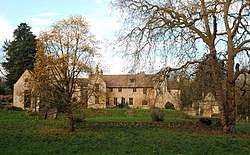Horton Court
| Horton Court | |
|
National Trust | |
|---|---|
 Horton Court | |
| Grid reference: | ST76628502 |
| Location: | 51°33’49"N, 2°20’19"W |
| Built 1521 | |
| Information | |
| Website: | Horton Court |
Horton Court is a stone-built 16th century manor house in Horton, near Chipping Sodbury in Gloucestershire. The building retains a 12th-century Norman hall, and displays some of the earliest Renaissance decorative motifs used in Britain. It has been a National Trust property since 1949.
The house was built in about 1521 by the Rev. William Knight (d. 1547), Prothonotary to the Holy See, and later Bishop of Bath and Wells.
The house was empty from 2008 to 2011 but the National Trust opened the ground floor on Friday and Sunday afternoons during July and August 2011 and are actively considering how to make it more readily accessible to the public.[1] It is a grade I listed building.[2]
Within the grounds is a Grade I listed ambulatory, built for William Knight around 1527-29.[3]
Before and after National Trust work
-
The Norman wing in 2005
-
After National Trust work in 2014
-
12th Century doorway
-
16th Century Ambulatory in 2005
History of the manor
Early in the 12th century Hubert de Rye donated the manor to the See of Sarum, which used the revenues to endow a prebend. An early Hubert of Ryes,[4] is known in legend as the loyal vassal who saved the life of Duke William of Normandy in his flight from Valognes during a revolt in 1047.[5] The first known holder of the prebend was Robert de Beaufeu, around 1150. It is believed he was the builder of the Norman great hall, which still survives as the core of the present 16th-century house built by Rev. William Knight (1476–1547), a prebendary from 1517.
Knight attended King Henry VIII at the Field of the Cloth of Gold in 1521 and in 1527 negotiated with the Pope over Henry's divorce from Catherine of Aragon. He was Bishop of Bath and Wells from 1541 until his death in 1547. During his travels he witnessed the art of the Italian Renaissance. He incorporated some of the motifs he had seen abroad into the new house he built in about 1521 at Horton around the Norman hall, and the house is thus one of the earliest houses in Britain to show Renaissance design features in Britain, most notably in the grotesque jambs of the front door, , comparable to Sutton Place, Surrey, and Hampton Court Palace.[6]
Following the Dissolution of the Monasteries Horton became crown property in 1550, and King Edward VI (1547–1553) granted it first to his uncle Protector Somerset and then in 1550 after his fall to Sir Edward Paston. A later Sir Edward (d.1630), a godson of King Edward VI, built Appleton Hall in in Norfolk, where the family lived for several generations until in 1767 a fire destroyed the house and they moved to Horton Court in Gloucestershire.[7]
The last of the Pastons mortgaged Horton Court to FitzHerbert Brooke, Esq., of Stanshaw's Court, Yate, a solicitor, who foreclosed and became himself the proprietor of the manor soon after 1800. Horton Court passed to his grandson Sir Frederick Richards (1833–1912), Admiral of the Fleet, who had married his daughter Lucy Fayle Brooke (d.1880), which marriage was without progeny. Richards made extensive alterations in 1884.[8]
In 1937 Horton Court was purchased by Miss Hilda Proctor Wills. At her death in 1946 she bequeathed the property to the National Trust in memory of her nephew Sir George Peter Vernon Wills, 3rd Baronet of Blagdon (1922–1945), of the Coldstream Guards, killed in action in Italy in 1945.
Outside links
| ("Wikimedia Commons" has material about Horton Court) |
- Horton Court: National Trust
- Horton Court information at the Tour UK
- National Heritage List 1114992: Horton Court
References
- ↑ Horton Court opened to public by National Trust BBC, 2 July 2011
- ↑ National Heritage List 1114992: Horton Court
- ↑ National Heritage List 1321166: Ambulatory 20 yards south west of Horton Court
- ↑ Keats-Rohan Domesday Descendants p. 194
- ↑ Douglas William the Conqueror p. 48 and footnote 8
- ↑ Kingsley, Nicholas. The Country Houses of Gloucestershire, Vol.1, 1500-1660, Cheltenham, 1989, pp.109-111, Horton Court
- ↑ Blomefield, Francis. An Essay Towards a Topographical History of County Norfolk, Vol.8, pp.328-332, Appleton
- ↑ Kingsley, p.111



